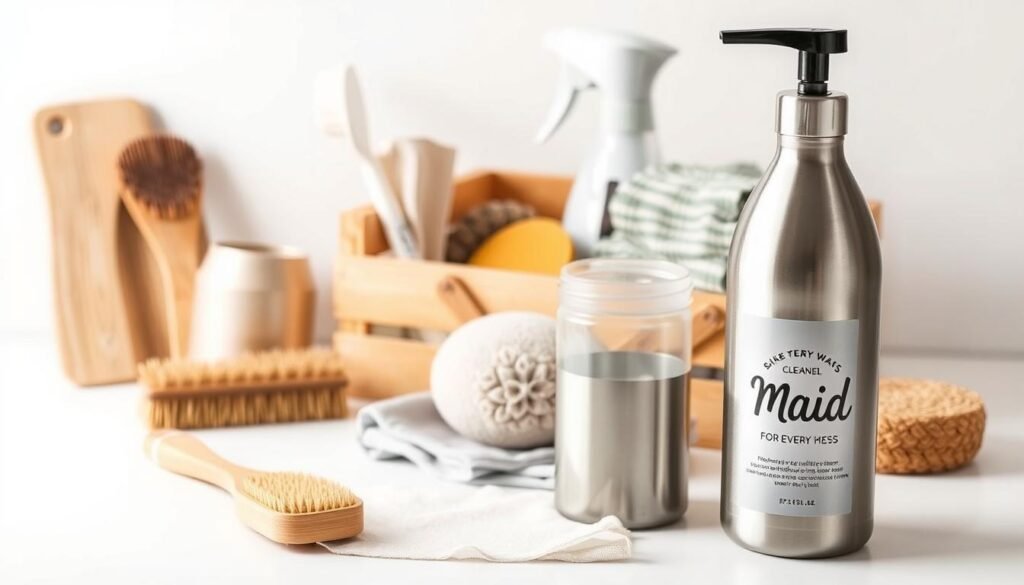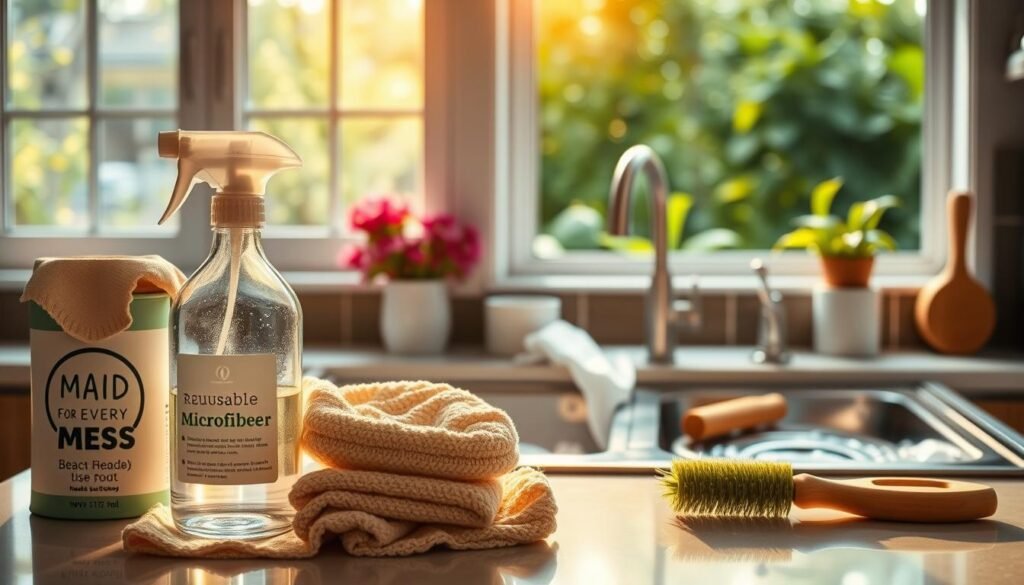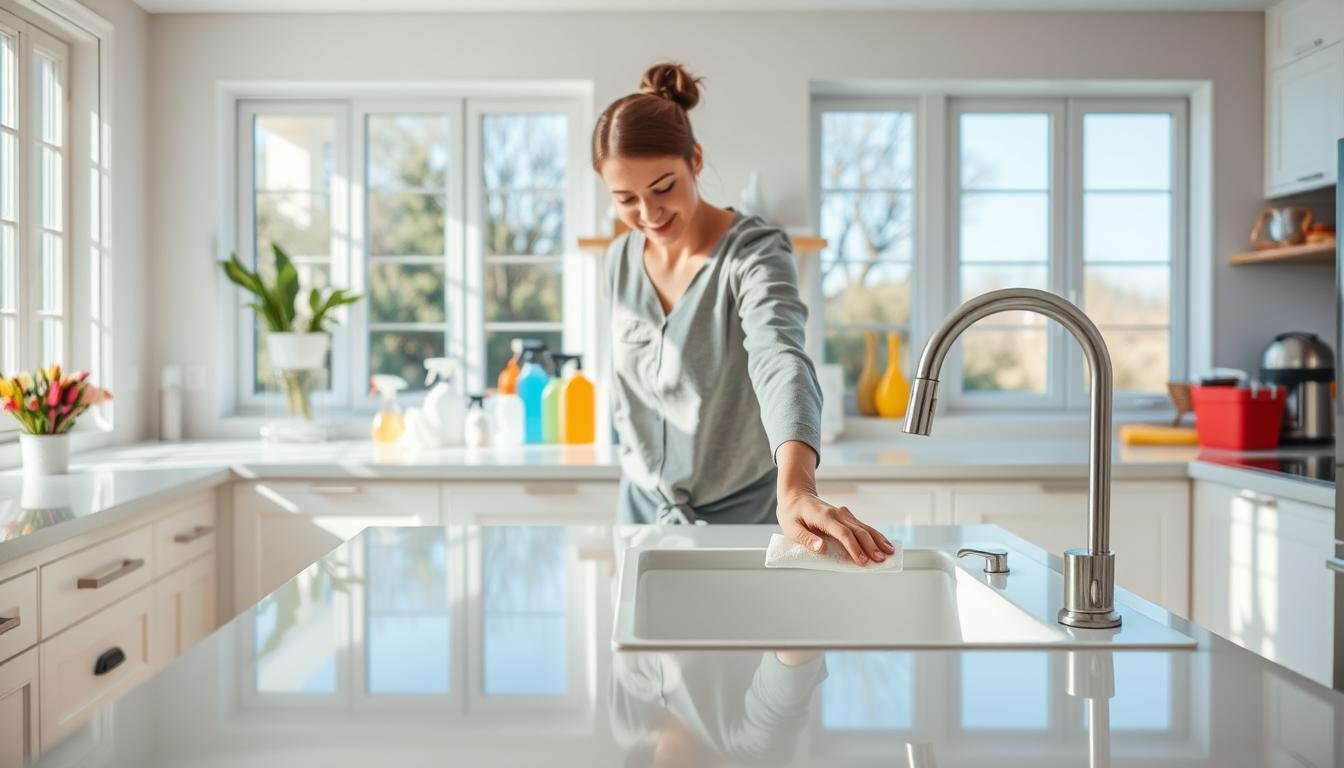Reducing waste in your cleaning routine is essential for protecting the environment and creating a more sustainable future. Traditional cleaning methods, such as relying on single-use wipes and paper towels, contribute to excessive waste that fills up landfills and pollutes our air and water. Additionally, plastic packaging for cleaning products generates up to 300 million tons of waste annually, most of which cannot be recycled. By making simple changes to reduce waste in your cleaning routine—like using reusable cloths, refillable containers, and eco-friendly products—you can minimize your environmental impact and help combat this growing problem. Reducing waste in your cleaning routine is not only better for the planet but also an easy way to embrace greener habits in your everyday life.
Household chemicals often contain harmful VOCs that make our air worse2. Using wool dryer balls instead of traditional sheets can save energy1. Good Housekeeping’s Monique Valeris suggests cutting down on paper and plastic to clean more sustainably. Services like Sweepsouth offer professional cleanings that are better for the environment1.
Key Takeaways
- Single-use products create millions of tons of landfill waste1.
- 300 million tons of plastic yearly include packaging for cleaning supplies1.
- DIY solutions cost less and avoid harmful chemicals2.
- Switching to laundry strips cuts plastic waste1.
- Regular vacuuming and deep cleaning schedules improve efficiency2.
Understanding the Environmental Impact of Traditional Cleaning
Traditional cleaning habits often hide hidden costs to the planet and health. By choosing eco-conscious cleaning practices, we can protect our ecosystems and make our homes safer. Let’s explore how our daily choices affect the environment.
Statistics on Cleaning Product Waste in America
In the U.S., 69% of streams have detergent residues, and 66% have disinfectant traces3. Every year, over 1 billion plastic cleaning bottles end up in landfills4. These numbers show the big problems with traditional cleaning methods.
These statistics highlight why it’s essential to reduce waste in your cleaning routine by switching to reusable products, refillable containers, and eco-friendly alternatives.
Common Sources of Waste in Household Cleaning
Disposable wipes, plastic bottles, and non-recyclable packaging are major waste contributors. Single-use products make up 40% of cleaning waste, but you can significantly reduce waste in your cleaning routine by opting for sustainable alternatives like biodegradable tools and reusable cloths.
Why Reducing Cleaning Waste Matters
Every decision we make counts. By reducing packaging waste and lowering chemical runoff, we can create a healthier home and planet.
By making small changes, such as switching to DIY cleaners or reusable tools, you can reduce waste in your cleaning routine while saving money and improving indoor air quality.
Assessing Your Current Cleaning Waste Footprint
Before you start making changes, it’s important to know where you are. Track disposable items like paper towels, spray bottles, and single-use wipes for two weeks. This will show you where to begin reducing household waste.
Tracking your habits is a great first step toward finding ways to reduce waste in your cleaning routine and adopting more sustainable practices.
- Count how often you buy disposable sponges or plastic scrubbers.
- Note brands and packaging types of current cleaning supplies.
- Record how much trash your cleaning routine adds to weekly garbage.
“The author still uses a plastic toilet brush that will last another decade” shows reusing functional items reduces replacement waste6. Avoid tossing working items like this brush just to buy eco-friendly options immediately. Finish existing products before upgrading to zero waste cleaning tips like microfiber cloths or refillable containers6.Start a logbook to note every product purchase and disposal. High-rated options like laundry detergent sheets (4.7/5 stars7) or castile soap can gradually replace items. Ask: “Does this product create unnecessary packaging or chemicals?”
Small shifts matter. Swapping one disposable item for a reusable cloth weekly builds eco-conscious cleaning habits. This audit creates a baseline to measure progress later.
Core Principles to Reduce Waste in Your Cleaning Routine
Switching to zero-waste cleaning methods benefits wallets, health, and the environment. Start small to avoid overwhelm8.
Starting with zero waste cleaning methods is simple. It’s about making small changes to reduce waste. By swapping disposable items for reusable ones, you help the planet and save money9.
The 5 Rs of Sustainable Cleaning
Here’s how to make your cleaning routine greener:
- Refuse single-use plastics. Choose bamboo brushes over plastic sponges. This is a big step in reducing plastic waste9.
- Reduce product counts. Use one cleaner for all instead of many.
- Reuse containers. Store your homemade cleaners in recycled glass bottles10.
- Repurpose old items. Use jars for DIY supplies or towels as scrubbers.
- Recycle only when necessary. Always check local guidelines for disposing of cleaning chemicals8.
Following these principles will help you reduce waste in your cleaning routine while making eco-friendly choices that benefit both your home and the planet.
Starting Small for Lasting Change
To reduce waste in your cleaning routine, start small by focusing on one room at a time and gradually replacing disposable items with reusable alternatives. This can save a lot of paper waste9.
Keep track of your progress with a weekly checklist:
- Replace one disposable item each month
- Track how much money you save with reusable tools
- Share your tips with neighbors to make a bigger impact
Setting Realistic Waste Reduction Goals
Set goals that are easy to achieve. For example:
| Goal | Action | Timeline |
|---|---|---|
| Plastic reduction | Swap 3 plastic cleaners for glass bottles | 6 weeks |
| Chemical waste | Make DIY cleaners with vinegar and baking soda | Monthly |
Minimalist Cleaning Supplies That Last Longer
Creating a cleaning toolkit that lasts is smart. It saves money and reduces waste. Using metal caddies and multi-use brushes means you don’t need to buy disposable items often. This approach supports waste-free cleaning at home.
Quality Over Quantity: Investing in Durable Tools
Go for tools that will last a long time. Stainless steel scrubbers are better than plastic ones. Vacuums with lifetime warranties, like Dyson models, mean you won’t need to replace them often. This reduces waste from broken tools11.
Choose handles with ergonomic grips and strong parts. This way, you won’t need to buy new tools as often.
Multi-Purpose Tools That Eliminate Redundancy
Microfiber cloths can clean glass, scrub surfaces, and polish wood. They replace paper towels and disposable wipes. One person has used their set for six years, saving over 1,000 disposable cloths12.
A basic cleaning caddy might include:
- Wooden dusters for dusting and sweeping
- Metal dustpans and brooms
- Bamboo mops with replaceable heads
Sustainable Materials to Look For
Choose materials over plastic for your tools. For example:
- Bamboo brushes for scrubbing dishes
- Silicone squeegees for shower tiles
- Cotton or linen cloths over synthetics
Look for tools with parts you can replace. This way, you can extend their life11. Metal or ceramic containers for DIY cleaners are also durable and cut down on plastic bottle waste.
“My microfiber mop head still works perfectly after 72 months of weekly use.” – EcoClean Review Team12
DIY Natural Cleaning Solutions Using Pantry Ingredients
Change your cleaning habits with waste-free cleaning strategies from your pantry. Eco-friendly cleaning solutions made at home avoid harmful chemicals and cut down on plastic waste. They match environment-friendly cleaning methods. Most DIY recipes use vinegar, baking soda, and citrus peels, items you likely have at home13.
Here are some recipes to try:
- All-Purpose Spray: Mix 1 cup water, 1 cup vinegar, and 5 drops tea tree oil. Shake well and spray on surfaces. It’s a big cut down on plastic bottle use compared to store-bought cleaners13.
- Stainless Steel Polish: Combine ¼ cup olive oil with 1 tbsp lemon juice for a streak-free finish.
- Tile Grout Cleaner: Sprinkle baking soda, spray with hydrogen peroxide, scrub, and rinse. It’s a great alternative to aerosol sprays14.
Sustainable Alternatives to Single-Use Cleaning Products
Switching to reusable products is key for zero waste cleaning tips. EcoSwiss offers durable microfiber cloths rated 4.7/5. They cut down paper towel use by 90%16
Replacing single-use wipes saves 60% on cleaning costs over two years
Reusable Cleaning Cloths and Wipes
- Microfiber cloths last 500+ washes and outperform disposable options17
- Bamboo fiber cloths biodegrade in 3-6 months after disposal
- Swedish dishcloths neutralize odors and dry quickly
Refillable Cleaning Containers and Systems
Plastic-Free Cleaning Tools
Choose Bambu‘s bamboo scrub brushes or Stasher‘s silicone storage bags rated 4.9/5 for durability16. Metal squeegees and compostable mop heads made from cornstarch are great for green cleaning strategies.
Room-by-Room Guide to Reduce Waste in Your Cleaning Routine
Starting green cleaning strategies means making each space unique. Use these tips to reduce waste and keep your home clean.
| Room | Action | Product |
|---|---|---|
| Kitchen | Swap sponges for bamboo scrubbers and make DIY all-purpose sprays using vinegar and essential oils18 | Dr. Bronner’s Castile Soap |
| Bathroom | Use refillable bottles for cleaners and scrub grout with baking soda paste18 | Biodegradable scrubbers |
| Bedroom | Line dry bedding weekly and air rooms daily to cut down on harsh sprays19 | Organic cotton sheets |
| Living Spaces | Switch to wool dryer balls and use microfiber-catching Guppyfriend bags during laundry19 | Cora Ball |
In the kitchen, choose sustainable cleaning products like reusable microfiber cloths. For bathrooms, go for bulk soap refills to reduce plastic waste18. Bedrooms are better with environmentally friendly cleaning habits like using old towels as dust cloths. Living areas benefit from wool dryer balls that save time and energy19.
Combine these minimizing waste in your cleaning routine steps with regular checks of your cleaning supplies. Replace items one at a time with zero-waste options to avoid feeling overwhelmed. These small changes can lead to significant reductions in household trash and chemical runoff.
Smart Storage Solutions to Extend Product Life
Smart storage is crucial for eco-conscious cleaning methods and reducing waste in home cleaning. Organizing supplies well helps products last longer, saves money, and cuts down on waste. It also stops products from going bad and makes cleaning more efficient, following the zero waste cleaning guide.
Proper Container Management
Choose containers that fit your needs. Glass jars are good because they don’t react with chemicals, and metal caddies keep tools organized. Make sure to label containers with what’s inside and when you put it there. Using vertical storage, like floor-to-ceiling shelves, can make your space up to 50% bigger20
Dilution Techniques for Concentrated Products
Using concentrated cleaners can help reduce packaging waste. Always dilute as directed, usually 1 part cleaner to 4 parts water, to avoid waste. Keep these concentrates in airtight containers. This method cuts down on plastic use and follows tips for zero waste cleaning. Reusing bottles can save 50% of space compared to disposable sprays20.
Preventing Contamination and Spoilage
Don’t mix different cleaners in the same container. Keep acids and alkalis apart. Use airtight jars for homemade cleaners to stop bacteria. Metal caddies help keep tools in order and prevent spills. Proper storage can make products last 30% longer or more20, which means less waste in landfills.>
Building New Habits: Daily Practices for Less Cleaning Waste
Small actions can lead to big changes. Start by adopting sustainable cleaning solutions in your daily life. A cleaning calendar can help you stay on track, reducing the need for big cleanups21. Here are some easy steps to reduce waste and save time:
- Keep shoes at the door to slash cleaning time by 30%21.
- Use natural fiber rugs needing weekly care, not daily mopping21.
- Put items back immediately to halve cleaning time21.
- Make the bed daily in 2 minutes to stay organized21.
- Wipe counters after meals to prevent buildup21.
- Do a 10-minute nightly tidy to keep spaces tidy21.
Composting food scraps can divert 25% of household trash from landfills22. Buying in bulk helps minimize cleaning product packaging23. Using refillable containers reduces plastic waste and saves money23. Choose sustainable cleaning supplies like microfiber cloths, which last longer than disposable ones23.
Zero waste hacks like daily routines can make your home tidy with less effort. Even small actions, like washing dishes every night, make a difference. A clean home can also improve your mental health, making you feel better21. Get everyone in your household involved to make cleaning a team effort and keep habits going.
Tackling Specific Waste Challenges in Cleaning
Water, packaging, and chemical disposal are big hurdles in cleaning without waste. By tackling these, homes can meet minimal waste goals. The EPA says 292 million tons of U.S. waste in 2018 came from cleaning products24. Here’s how to tackle these problems.
Reducing Water Waste While Cleaning

Modern dishwashers use 3-5 gallons per cycle, much less than handwashing’s 20 gallons.
Energy Star-certified dishwashers save up to 12,000 gallons a year per household.
Turn off taps while cleaning and save rinse water for mopping. Use reusable spray bottles to cut down on plastic and water.
Managing Packaging Waste
- Buy concentrated cleaning formulas to reduce plastic bottle count
- Reuse glass jars for DIY cleaners instead of buying new containers
- Recycle rigid plastics #1-#2 through curbs-side programs
Corrugated cardboard can become new boxes or insulation25. Check local hazardous waste facilities for expired cleaners—never pour down drains.
Addressing Chemical Waste and Disposal
Many cleaners have microplastics or ammonia that water plants can’t filter24. Use vinegar-based cleaners and dispose of old products at hazardous waste sites. Never flush expired products—this harms soil and water. Look for EPA Safer Choice labels to avoid harmful chemicals.
By following these steps, we can make a big difference. Small actions like refilling containers and choosing eco-certified products make cleaning sustainable. Proper disposal prevents 4.9 pounds of daily household waste per American from becoming pollution24.
Eco-Friendly Brands and Products Worth Trying
Choosing eco-friendly brands makes cleaning easier on the planet. Blueland’s dissolvable tablets reduce packaging waste by 90%26. This is a big step towards reducing waste. Seventh Generation’s cleaners are plant-based and EPA Safer Choice-certified26. Dropps laundry pods are made without dyes, offering a zero-waste option26.
Smol’s plastic-free laundry capsules and Who Gives A Crap’s biodegradable products27 show how to reduce waste. These brands follow the 5 Rs of sustainable cleaning. Start with Blueland’s $46 Clean Essentials Kit or JAWS’ $100 system for a low-waste routine. Every switch helps reduce environmental impact, showing small changes can make a big difference.
FAQ
What are the environmental impacts of traditional cleaning products?
Traditional cleaning products can harm the environment. They often lead to plastic pollution and chemical runoff. Items like paper towels and plastic bottles contribute to single-use waste, harming wildlife.
How can I assess my current cleaning waste footprint?
Start by making a list of disposable products you use often. This includes paper towels, wipes, and plastic bottles. Keep track of how often you buy and throw away these items for a few weeks.
What are the 5 Rs of sustainable cleaning?
The 5 Rs are Refuse, Reduce, Reuse, Repurpose, and Recycle. These principles help you manage waste and reduce environmental impact.
What are some examples of multi-purpose cleaning tools?
Tools like microfiber cloths can dust, clean, and polish surfaces. A good mop can handle both wet and dry cleaning, cutting down on the need for multiple products.
How can I make my own eco-friendly cleaning solutions?
Use pantry items like vinegar, baking soda, and lemon juice to make DIY cleaners. For example, mix equal parts vinegar and water for a versatile all-purpose cleaner.
What should I look for in sustainable cleaning products?
Look for products that are refillable and made from plant-based or biodegradable materials. Avoid those with too much plastic. Choose brands that offer concentrate refills.
How can I tackle water waste during cleaning?
Use a dishwashing machine to save water compared to handwashing. Also, adopt low-water cleaning methods and reuse water for tasks like mopping.
What are the best practices for storing homemade cleaning products?
Store homemade cleaners in glass containers and label them. Keep your storage area cool and dry to prevent spoilage and ingredient degradation.
What are some strategies for building sustainable cleaning habits?
Begin by using cleaning supplies mindfully and establish regular cleaning routines. Involve your family in waste reduction efforts. Gradually add new habits to make sustainable cleaning easier.
Can you recommend any eco-friendly brands for cleaning products?
Yes, Seventh Generation, Method, and Ecover offer eco-friendly cleaning products. Also, look for local companies that focus on sustainable practices and packaging.




